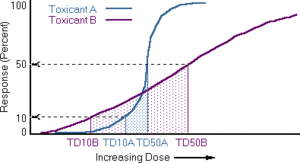|
We measure toxicity by the dose at which adverse effects are produced, and usually determine toxicity by administering
various doses to populations of laboratory animals and measure the responses. We assume that if the lethal dose-50% is low,
the toxic potential is high for humans as well. Dose-response curves are created by scientists testing effects of high doses
and working their way down to a threshold level. However, it cannot be assumed that doses lower than the threshold level will
not have an effect. As the effects of low doses are diffcult to measure, scientists resort to extrapolation of their data
to lower doses.
However, problems arise during low-dose extrapolation:
- Though laboratory animals (often mammals) are similar to humans, it is uncertain whether humans may respond similarly
to exposure to the same chemical.
- Humans are exposed to much lower amounts of the toxin over longer periods of time. Estimates of risk associated with exposure
to low levels are generally obtained by linear extrapolation from higher exposure levels at which risks can be estimated directly.
However, it can not be simply assumed (no evidence that it is scientifically sound) that one can work backwards
from huge doses of chemicals and their effects to determine the expected effects in humans exposed to lower amounts of the
same chemicals. Linear extrapolation is not dependable because we cannot assume that the slope at the threshold level will
continue for lower doses.
- Comparing chemicals' LD50's to determine their safety is an over-simplified approach. It is simply one point on the
dose-response curve that reflects the potential of the compound to cause death. In assessing chemical safety, the threshold
dose and the slope of the dose-response curve are much more important. It is possible that a chemical will produce an
undesirable toxic effect at doses which cause no deaths at all.

|

